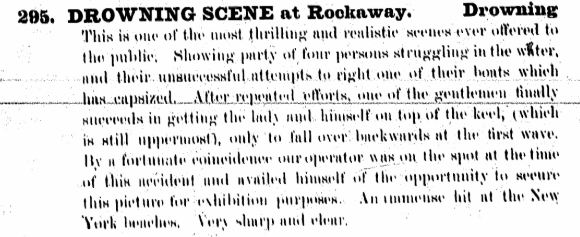Drowning Scene at Rockaway (lost film of alleged legitimate drowning accident; 1897)
Drowning Scene at Rockaway is an 1897 supposed actuality film. Produced by the International Film Company and released in July 1897, it allegedly depicts a boating accident involving four occupants, who ultimately drowned beneath the waves of Rockaway Beach in New York. The film's lost status and the International Film Company's hyperbole-filled synopsis make it difficult to determine whether the film depicted a real tragedy or was a fake designed to lure in unsuspecting viewers.
Background
The International Film Company was formed in October 1896 by Charles H. Webster and Edmund Kuhn.[1][2][3] Both had worked for the Vitascope Company and Edison Manufacturing Company respectively,[4][1] with their initial business plan being to sell reproductions of Edison's early works.[2] Such a practice was surprisingly lawful in an era shortly before Edison copyrighted his productions.[5] However, the company soon produced its own unique 35mm film strips ranging from 50 to 150 feet in length.[6][2][1] Among the films it worked on included The Horitz Passion Play, which is considered the first production to be filmed in the Czech Republic.[7][4] It also released the projectograph in December 1896, becoming the most affordable projector at only $200.[2][3][4] Alas, the International Film Company's lifespan was rather short and its fate was sealed when Edison began copyrighting his productions and took extensive legal action against his competitors.[8][1] The first target on Edison's list, the International Film Company opted to cease operations in 1898 rather than risk a lengthy legal fight and possible bankruptcy.[9][4]
Before its closure, the International Film Company released International Photographic Films to showcase its works.[6] Instead of establishing its own viewing parlours, the organisation sold its films for $10-$30 to interested exhibitors.[1][6] It also promised to provide the occasional colourised film as an optional extra.[6] A summary of its productions indicates the company focused on actuality films, priding itself on releasing "realistic" and "sharp and clear" quality works.[6] Among its known surviving works include School Is Out, which showed a set of schoolboys playfighting at a beach;[10] and Dewar's Scotch Whiskey/Scotch Dance, an advertisement showing four Scotsmen drunkenly dancing after presumably having had multiple Dewar's.[11][6][4] But whereas those two films were innocent in nature, other works focused on more taboo subjects.[6] For instance, Scalping Scene by Thundercloud depicted a tenderfoot being scalped by "Thundercloud", who is slated to have been a "genuine" Native American.[6]
Drowning Scene at Rockaway
At least two other films were promoted as featuring legitimate scenes of death.[12][13] Drowning Scene at Rockaway was a 50-foot recording that was first released to exhibitors in July 1897.[14][6] According to the official synopsis, a cameraman situated at Rockaway Beach in New York stumbled upon and opted to capture a scene of tragedy unfolding in front of him. Two boats containing four individuals had capsized within the strong tide. In an attempt to right their boat, a man helps a woman up to its keel. However, they are then subsequently hit by a wave and fall back into the sea, resulting in them and the other pair drowning in the raging waters.[6][14][12] Exactly whether the film depicts a legitimate drowning incident is unclear. In his essay titled Cataloging Contingency, Jonathan Auerbach noted several examples of hyperbole statements made in the official synopsis, including how it was "By a fortunate coincidence" that the cameraman happened to be "on the spot" when the incident occurred.[12][6] However, he also notes that the chance recording, plus the lack of information concerning the four victims and their fates, means there is an unlikely, but not necessarily impossible chance the film's content was real.[12]
A similar example is noted by Mario Slugan concerning the International Film Company work Lynching Scene, A Genuine Lynching Scene.[13][6] The film, which allegedly saw a riotous crowd execute a prisoner somewhere in Texas, was subsequently released by the organisation after agreeing to authorities not to disclose the victim's identity nor where it transpired.[13][6] Slugan notes that the synopsis' vague nature, as well as the fact some photographers were invited to lynchings before they took place, means it is impossible to determine whether the film was indeed legitimate or a fake.[13] However, Drowning Scene most likely was a forgery. For example, a search of The New York Times indicated only two drownings at Rockaway were reported in 1897.[15][16] These included a man's body found at Rockaway after having reportedly drowned;[15] and a girl who saved her brother from drowning at the beach.[16] Both incidents transpired after July 1897 and share no similarities to the accident detailed in Drowning Scene at Rockaway's synopsis.[14][6]
Another suspicious aspect concerns another produced film titled Fishing and Capsizing. This work depicts two couples enjoying a fishing trip when one loving pair ends up capsizing and falling into the sea. The other couple then try to rescue them, in a production promoted as "A most laughable subject". The apparent narrative similarities between Fishing and Capsizing and Drowning Scene at Rockaway are clear, making it possible the former served as a prequel to the latter.[6] If this is true, then Drowning Scene at Rockaway might have instead been designed to trick none-the-wiser viewers into seeing a forgery.[12] The most damning evidence supporting this was that the organisation once claimed to have captured footage of the USS Maine while she was situated at Havana Harbour.[17] Promoted as a genuine article taken before Maine sank on 15th February 1898,[18] the reality was that it actually captured Maine's sister ship.[17] This practice frequently happened in early filmmaking; for example, Lubin was infamous for ripping off customers by promoting his "reproductions" of boxing matches like James J. Corbett vs Bob Fitzsimmons as being the real bouts.[19] Still, despite depicting a tragic event regardless of whether it was real or fake, the International Film Company marketed it as "one of the most thrilling and realistic scenes ever offered to the public."[6]
Availability
Ultimately, Drowning Scene at Rockaway has been declared as a lost film, with the majority of the International Film Company's works having also not survived the test of time.[12] The reasons behind the film's disappearance are not known, though it is presumably among over 90% of pre-1929 American works that will never be recovered due to poor preservation efforts.[20]
See Also
- Downey-Paterson Fight (lost early boxing film; 1897)
- Lynching Scene: A Genuine Lynching Scene (lost film of alleged legitimate lynching incident; 1897)
References
- ↑ 1.0 1.1 1.2 1.3 1.4 Rutgers-New Brunswick School of Arts and Sciences summarising the founding and early history of the International Film Company. Retrieved 1st May '24
- ↑ 2.0 2.1 2.2 2.3 The Emergence of Cinema: The American Screen to 1907 summarising the establishment of the International Film Company and the creation of its projectograph (p.g. 167). Retrieved 1st May '24
- ↑ 3.0 3.1 Chronology of the Birth of Cinema 1833–1896 summarising the timeline of International Film Company's formation and its projectograph (p.g. 137). Retrieved 1st May '24
- ↑ 4.0 4.1 4.2 4.3 4.4 Who's Who of Victorian Cinema biography on Webster. Retrieved 1st May '24
- ↑ Before the Nickelodeon: Edwin S. Porter and the Edison Manufacturing Company summarising how the International Film Company's early Edison duplicates were perfectly legal (p.g. 153). Retrieved 1st May '24
- ↑ 6.00 6.01 6.02 6.03 6.04 6.05 6.06 6.07 6.08 6.09 6.10 6.11 6.12 6.13 6.14 6.15 International Photographic Films, 1897-1898 providing film summaries of the majority of the International Film Company works. Retrieved 1st May '24
- ↑ r/lostmedia post discussing The Horitz Passion Play. Retrieved 1st May '24
- ↑ American Cinema 1890-1909: Themes and Variations summarising Edison's extensive legal action that caused numerous film companies to leave the industry (p.g. 48). Retrieved 1st May '24
- ↑ Before the Nickelodeon: Edwin S. Porter and the Edison Manufacturing Company noting the International Film Company closed its doors to avoid legal action from Edison (p.g. 115). Retrieved 1st May '24
- ↑ School Is Out, a 15-second film. Retrieved 1st May '24
- ↑ Dewar's Scotch Whiskey/Scotch Dance, a 30-second film. Retrieved 1st May '24
- ↑ 12.0 12.1 12.2 12.3 12.4 12.5 Cataloging Contingency summarising Drowning Scene at Rockaway and questioning its authenticity (found in Networks of Entertainment: Early Film Distribution 1895-1915, p.g. 205). Retrieved 1st May '24
- ↑ 13.0 13.1 13.2 13.3 The turn-of-the-century understanding of 'fakes' in the US and Western Europe summarising Lynching Scene: A Genuine Lynching Scene and how there is a small possibility the film could be legitimate (p.g. 735). Retrieved 1st May '24
- ↑ 14.0 14.1 14.2 July 1897 issue of The Phonoscope promoting Drowning Scene (p.g. 14). Retrieved 1st May '24
- ↑ 15.0 15.1 10th October 1897 issue of The New York Times reporting on the discovery of a man's body believed to have drowned at Rockaway. Retrieved 1st May '24
- ↑ 16.0 16.1 5th November 1897 issue of The New York Times reporting on a girl saving her brother from being drowned. Retrieved 1st May '24
- ↑ 17.0 17.1 The Emergence of Cinema: The American Screen to 1907 summarising a film that the International Film Company misled viewers into believing it featured USS Maine (p.g. 167). Retrieved 1st May '24
- ↑ Naval History and Heritage Command summarising the sinking of USS Maine. Retrieved 1st May '24
- ↑ The First CineMakers summarising Lubin and his practice of "reproducing" boxing bouts. Retrieved 1st May '24
- ↑ The Film Foundation reporting on the majority of silent American films being declared lost forever. Retrieved 1st May '24

